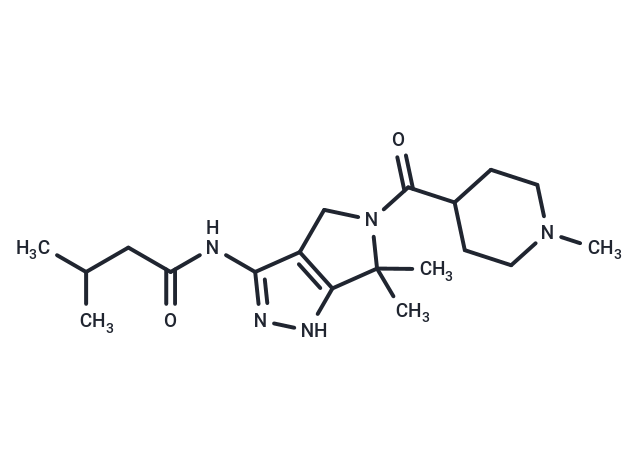Shopping Cart
- Remove All
 Your shopping cart is currently empty
Your shopping cart is currently empty

PHA-793887 has been used in trials studying the treatment of Advanced/Metastatic Solid Tumors.

| Pack Size | Price | Availability | Quantity |
|---|---|---|---|
| 1 mg | $45 | In Stock | |
| 2 mg | $64 | In Stock | |
| 5 mg | $107 | In Stock | |
| 10 mg | $162 | In Stock | |
| 25 mg | $325 | In Stock | |
| 50 mg | $556 | In Stock | |
| 100 mg | $783 | In Stock | |
| 500 mg | $1,650 | In Stock | |
| 1 mL x 10 mM (in DMSO) | $108 | In Stock |
| Description | PHA-793887 has been used in trials studying the treatment of Advanced/Metastatic Solid Tumors. |
| Targets&IC50 | CDK5-p25:5 nM, CDK2-CyclinE:8 nM, CDK7-CyclinH:10 nM, CDK2-CyclinA:8 nM, CDK1-CyclinB:60 nM |
| In vitro | PHA-793887, at a dosage of 20 mg/kg, has been demonstrated to be effective in treating transplant tumor models carrying K562 and HL60 cells, primary leukemia dissemination cell models, and high-burden disseminated ALL-2 models in relapsed Philadelphia-positive acute lymphoblastic leukemia patients. Additionally, PHA-793887 (administered at doses ranging from 10-30 mg/kg) exhibits good efficacy in xenograft models of human ovarian A2780, colon HCT-116, and pancreatic BX-PC3 cancers. |
| In vivo | PHA-793887 induces cell cycle arrest and inhibits Rb protein and nuclear phosphorylation at concentrations ranging from 0.2-1 μM, while also regulating the expression of cyclin E and cdc6. At 5 μM, it prompts apoptosis. This compound displays cytotoxicity towards leukemia cell lines (including K562, KU812, KCL22, and TOM1) with an IC50 of 0.3-7 μM, yet it shows no cytotoxic effects on normal, unstimulated peripheral blood mononuclear cells or CD34+ hematopoietic stem cells. PHA-793887 exhibits high activity against leukemia cell lines with an IC50 of <0.1 μM. Furthermore, PHA-793887 inhibits the proliferation of several tumor cell lines (including A2780, HCT-116, COLO-205, C-433, DU-145, A375, PC3, MCF-7, and BX-PC3) with IC50 values ranging from 88 nM to 3.4 μM. |
| Kinase Assay | CDK Kinase Assay: The biochemical activity of compounds is determined by incubation with specific enzymes and substrates, followed by quantitation of the phosphorylated product. PHA-793887 (1.5 nM–10 μM) is incubated for 30?90 min at room temperature in the presence of ATP/33P-γ-ATP mix, substrate, and the specific enzyme (0.7?100 nM) in a final volume of 30 μL of kinase buffer, using 96 U bottom plates. After incubation, the reaction is stopped and the phosphorylated substrate is separated from nonincorporated radioactive ATP using SPA beads, Dowex resin, or Multiscreen phosphocellulose filter as follows: (1) For SPA Assays. The reaction is stopped by the addition of 100 μL of PBS + 32 mM EDTA + 0.1% Triton X-100 + 500 μM ATP, containing 1 mg of streptavidin-coated SPA beads. After 20 min of incubation for substrate capture, 100 μL of the reaction mixture is transferred into Optiplate 96-well plates containing 100 μL of 5 M CsCl, left to stand for 4 hours to allow stratification of beads to the top of the plate, and counted using TopCount to measure substrate-incorporated phosphate. (2) For Dowex Resin Assay. An amount of 150 μL of resin/formate, pH 3.00, is added to stop the reaction and capture unreacted 33P-γ-ATP, separating it from the phosphorylated substrate in solution. After 60 min of rest, 50 μL of supernatant is transferred to Optiplate 96-well plates. After the additon of 150 μL of Microscint 40, the radioactivity is counted in the TopCount. (3) For Multiscreen Assay. The reaction is stopped with the addition of 10 μL of EDTA (150 mM). An amount of 100 μL is transferred to a MultiScreen plate to allow substrate binding to phosphocellulose filter. Plates are then washed three times with 100 μL of H2PO4 (75 mM) filtered by a MultiScreen filtration system, and dried. After the additon of 100 μL of Microscint 0, radioactivity is counted in the TopCount. IC50 values are obtained by nonlinear regression analysis. |
| Cell Research | Cells are seeded into 96- or 384-wells plates at final concentration ranging from 1 × 104 to 3 × 104 per cm2. After 24 hours, cells are treated using serial dilution of PHA-793887. At 72 hours after the treatment, the amount of cells are evaluated using the CellTiter-Glo assay. IC50 values are calculated using a sygmoidal fitt(Only for Reference) |
| Alias | PHA793887, PHA 793887 |
| Molecular Weight | 361.48 |
| Formula | C19H31N5O2 |
| Cas No. | 718630-59-2 |
| Smiles | CC(C)CC(=O)Nc1n[nH]c2c1CN(C(=O)C1CCN(C)CC1)C2(C)C |
| Relative Density. | 1.176 g/cm3 (Predicted) |
| Storage | Powder: -20°C for 3 years | In solvent: -80°C for 1 year | Shipping with blue ice. | |||||||||||||||||||||||||||||||||||
| Solubility Information | Ethanol: 67 mg/mL (185.35 mM), Sonication is recommended. DMSO: 55 mg/mL (152.15 mM), Sonication is recommended. H2O: < 1 mg/mL (insoluble or slightly soluble) | |||||||||||||||||||||||||||||||||||
Solution Preparation Table | ||||||||||||||||||||||||||||||||||||
DMSO/Ethanol
| ||||||||||||||||||||||||||||||||||||

Copyright © 2015-2025 TargetMol Chemicals Inc. All Rights Reserved.